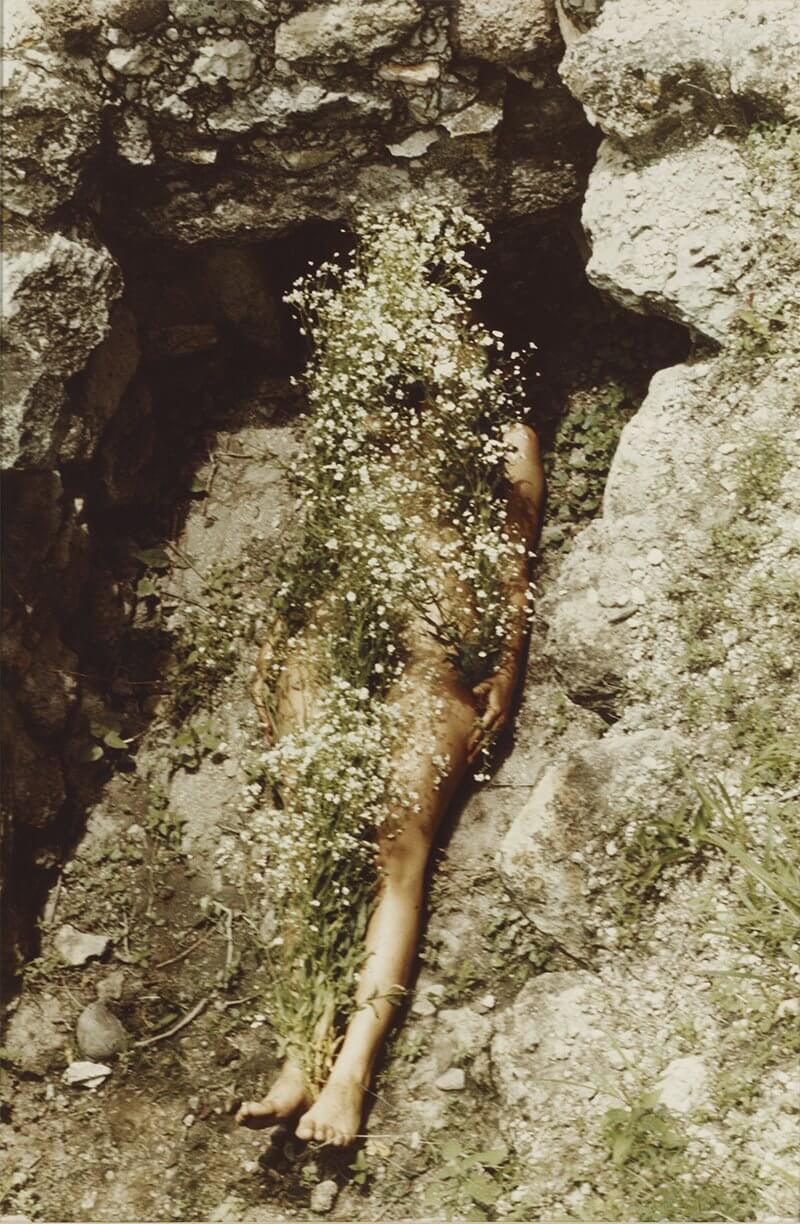
Ana Mendieta, Imágen de Yágul , 1973
Ana Mendieta’s journey home
by Rebecca Bengal

Portrait of Ana Mendieta © The Estate of Ana Mendieta Collection, LLC.
Courtesy of Galerie Lelong, New York
In her blazing and brief lifetime, the visionary artist ana mendieta created transformative works using her own body in conversation with the earth.
Born in Havana, Cuba, in 1948, she was the daughter of a teacher and a prominent politician who had joined anti-Castro counter-revolutionary forces. When Ana was 12, she and her 15-year-old sister Racquelin were flown to the U.S.A. with the aid of an organization that assisted the emigration of Miami in 1961, before being transferred to Dubuque, Iowa.
The metaphoric distance between Iowa and Cuba was immense, particularly for two teenage girls severed from their family and the place of their youth. Five years would pass before they were finally reunited with their mother and younger brother in 1966; thirteen more before they saw their father, after he was freed from a Cuban prison.
In those ensuing years,
the sisters sought
solace in art.
DRAWN TO PRIMORDIAL ELEMENTS, MAYAN CEREMONY, SANTERIA RITUALS, AS WELL AS ANCIENT AND INDIGENOUS SPIRITUALITY ROOTED IN THE EARTH,
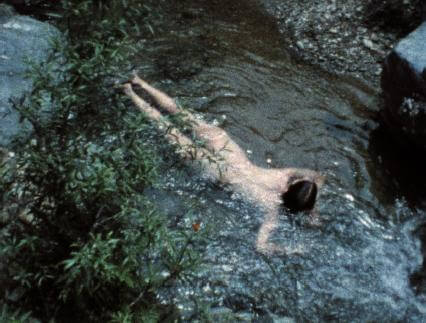
Ana Mendieta, Creek, 1974
Ana studied painting at the University of Iowa. Throughout her lifetime, she would collect bits of earth from places she felt she connected. “She called it a charge,” her sister Racquelin told an interviewer. “An object would have a charge, it would have the vibration of that place.”
While studying in Iowa, Mendieta began to make the earliest of the “earth body sculptures” she would record in photography and film. Lying face down on the ground, she asked her fellow students to glue blades of grass to her naked body. This process evolved into the Silueta series, photographs and films of sculptural, ephemeral performances in which she concealed her body among trees and rocks or embedded it in the landscape, leaving deliberate impressions of her body in the earth.
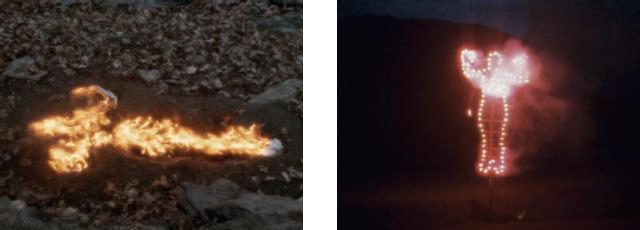
Left: Ana Mendieta, Silueta en Fuego , 1975
Right: Ana Mendieta, Silueta de Cohetes , 1976
Mendieta’s work speaks to that of her peers—body artist Bruce Nauman, feminist innovator Carolee Schneemann, and Land Artist Robert Smithson. But while Land Artists tended to envision earthworks of grand size, Mendieta’s artworks were scaled to the size of the human form. At the core of the Siluetas is the intimate encounter that exists between body and earth.
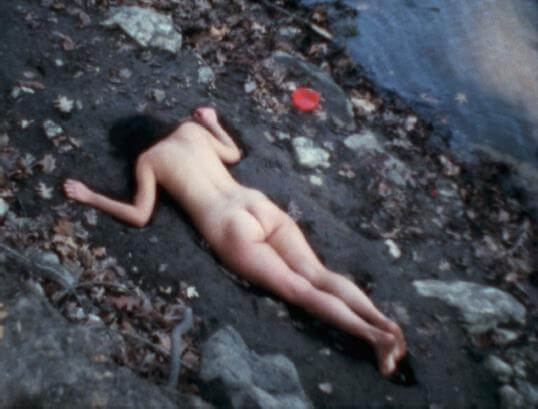
Ana Mendieta, Corazon de Roca con Sangre, 1975
“My art is grounded in the
belief of one universal
energy which runs through
everything: from
insect to man...
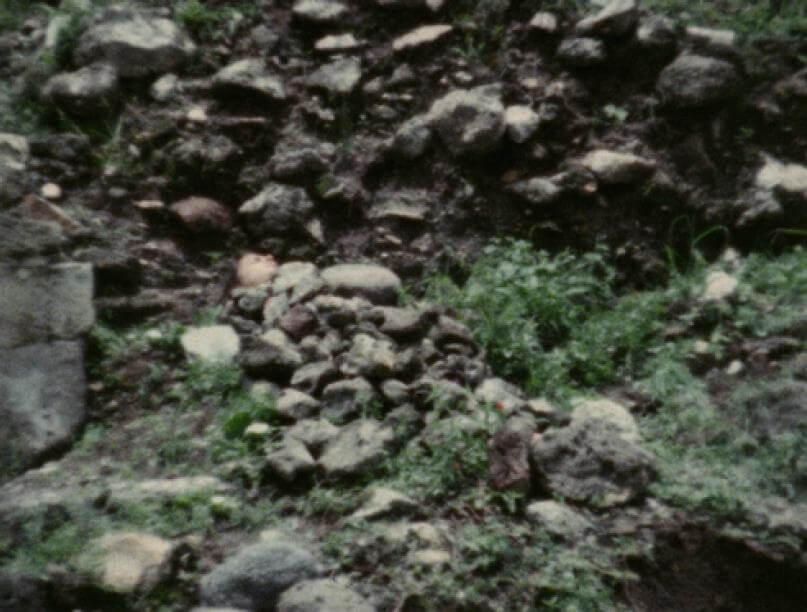
Ana Mendieta, Burial Pyraid, 1974
...from man to spectre,
from spectre to plant, from
plant to galaxy,”
- Ana Mendieta
“These obsessive acts of reasserting my ties with the earth are really a manifestation of my thirst for being,” she said. “In essence my works are the reactivation of primeval beliefs at work within the human psyche.”
In 1973, in what would become one of her most famous works, Imágen de Yágul, Mendieta covered her naked body in white flowers and placed herself in a tomb at the Mesoamerican site of Yágul. Her figure became subsumed in the earth. “My art is grounded in the belief of one universal energy which runs through everything: from insect to man, from man to spectre, from spectre to plant, from plant to galaxy,” she wrote.
Flowers, tree branches, paint, gunpowder, blood, and fire were among the tools she used to transmit that energy. In her film Anima, Silueta de Cohetes (Firework Piece, 1976), her silhouette was represented as an effigy, set ablaze with fireworks, each ember eventually flickering and fading and returning to total darkness.
It was a crucial step in a trajectory through her physical body – and one
that would eventually bring her home.
“THESE OBSESSIVE ACTS OF REASSERTING MY TIES WITH THE EARTH ARE REALLY A MANIFESTATION OF MY THIRST FOR BEING,” SHE SAID. “IN ESSENCE MY WORKS ARE THE REACTIVATION OF PRIMEVAL BELIEFS AT WORK WITHIN THE HUMAN PSYCHE.”
“For the last twelve years I have been carrying on a dialogue between the landscape and the female body. Having been torn from my homeland (Cuba) during my adolescence, I am overwhelmed by the feeling of having been cast out from the womb (Nature),” she said in an artist’s statement two years before her death in 1985, at age thirty-six.
In 1980 and 1981, Mendieta returned to Cuba on a Guggenheim fellowship. Here she began a process of reconnecting herself to the land of her origins, and the primordial stories buried within it. She traced female forms on the beach in Guanabo. She carved her Esculturas Rupestres (Rupestrian Sculptures), based on ten Taíno female deities, into the limestone caves and cliffs of Escaleras de Jaruco national park.
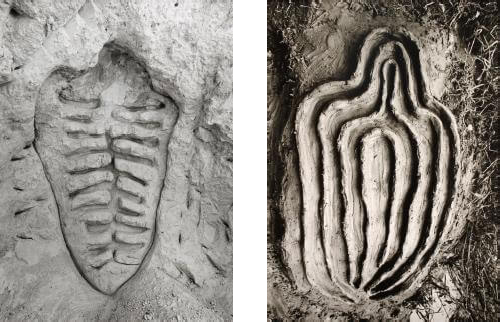
Left: Ana Mendieta, Itiba Cuhababa, 1981
Right: Ana Mendieta, La Vivificación de la Carne, 1982
THIS SERIES, INCLUDING GUANAROCA [FIRST WOMAN], REPRESENTS A HEALING, TOO, AN EXTENSION OF MENDIETA’S OWN SILHOUETTE. THE SHAPES OF THE ESCULTURAS RUPESTRES ARE SACRED AND PRIMORDIAL, THE ROUNDNESS A SIGNIFIER OF THE CIRCULARITY OF MENDIETA’S PRODIGAL PATH.
Returned to her
homeland, the artist
again embedded her body
in the earth, uniting it
with the spiritual forces
of creation.
Images and quotes by Mendieta © The Estate of Ana Mendieta Collection, LLC, Courtesy Galerie Lelong & Co.






